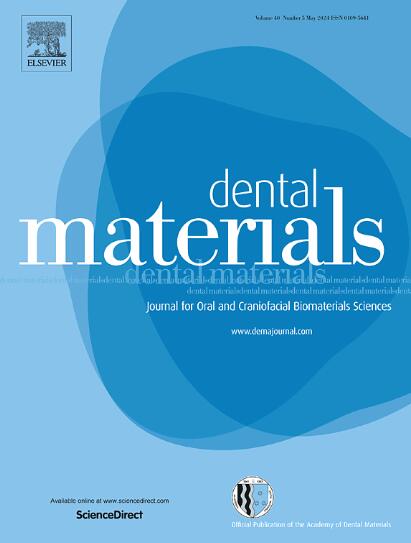Cement layer thickness and load-bearing capacity of tooth restored with lithium-disilicate glass ceramic and hybrid ceramic occlusal veneers
IF 6.3
1区 医学
Q1 DENTISTRY, ORAL SURGERY & MEDICINE
引用次数: 0
Abstract
Objectives
To evaluate the influence of cement layer and veneer thickness on load-bearing capacity of tooth restored with hybrid ceramic (HC) and lithium-disilicate glass ceramic (LDGC) occlusal veneer restorations.
Methods
Cement layer thickness was set at either 50 µm or 200 µm and tooth restored either with 0.5 mm or 1.8 mm thick HC Cerasmart270 (GC) or LDGC IPS e.max CAD (Ivoclar Vivadent) occlusal veneers. For this study, 64 extracted human molar teeth were selected and divided into 8 groups. Prepared teeth were scanned, and occlusal veneers were manufactured using CAD/CAM technology (Cerec, Dentsply-Sirona). Finished veneers were luted to preparations using self-adhesive resin cement (G-CEM ONE) according to manufacturers’ instructions. Teeth were loaded quasi-statically and ultimate fracture loads were recorded. Fracture types were analyzed and classified visually. Statistical analysis was performed using two-way ANOVA.
Results
With HC occlusal veneers, thickness of both veneer and cement layer had no significant influence on fracture load. The lowest mean ultimate fracture load value was found in 0.5 mm thick LDGC veneers group with 200 µm cement layer, which was significantly lower loading value compared with that of 1.8 mm thick LDGC veneers or any of HC veneers (p ≤ 0.0280). LDGC veneers with 0.5 mm thickness showed fractures within the veneer, whereas in other groups fractures of the tooth substance was also detected.
Conclusions
Within the limitations of this study, it can be concluded that thin HC occlusal veneers provided higher load-bearing capacity than LDGC counterparts of the same thickness. HC veneers were also less sensitive to the effect of cement layer thickness.
二硅酸锂玻璃陶瓷与混合陶瓷咬合贴面修复牙体的骨水泥层厚度及承载能力。
目的:评价复合陶瓷(HC)和二硅酸锂玻璃陶瓷(LDGC)牙合贴面修复体中骨水泥层和贴面厚度对牙合承载能力的影响。方法:将骨水泥层厚度设置为50µm或200µm,用0.5 mm或1.8 mm厚的HC Cerasmart270 (GC)或LDGC IPS e.max CAD (Ivoclar Vivadent)咬合贴面修复牙齿。本研究选择拔除的人磨牙64颗,分为8组。扫描准备好的牙齿,使用CAD/CAM技术(Cerec, Dentsply-Sirona)制作咬合贴片。根据制造商的说明,将完成的贴面涂在使用自粘树脂水泥(G-CEM ONE)的制剂上。对牙齿进行准静态加载,并记录极限断裂载荷。对骨折类型进行直观分析和分类。采用双因素方差分析进行统计分析。结果:HC牙合贴面时,贴面厚度和骨水泥层厚度对骨折负荷均无显著影响。平均极限断裂载荷值在200µm水泥层厚度为0.5 mm的LDGC贴面组最低,显著低于1.8 mm的LDGC贴面组和任何HC贴面组(p≤0.0280)。厚度为0.5 mm的LDGC贴面出现了贴面内部的断裂,而其他组的牙体也出现了断裂。结论:在本研究的限制范围内,可以得出薄HC咬合贴面比相同厚度的LDGC贴面具有更高的承载能力。HC单板对水泥层厚度的影响也不太敏感。
本文章由计算机程序翻译,如有差异,请以英文原文为准。
求助全文
约1分钟内获得全文
求助全文
来源期刊

Dental Materials
工程技术-材料科学:生物材料
CiteScore
9.80
自引率
10.00%
发文量
290
审稿时长
67 days
期刊介绍:
Dental Materials publishes original research, review articles, and short communications.
Academy of Dental Materials members click here to register for free access to Dental Materials online.
The principal aim of Dental Materials is to promote rapid communication of scientific information between academia, industry, and the dental practitioner. Original Manuscripts on clinical and laboratory research of basic and applied character which focus on the properties or performance of dental materials or the reaction of host tissues to materials are given priority publication. Other acceptable topics include application technology in clinical dentistry and dental laboratory technology.
Comprehensive reviews and editorial commentaries on pertinent subjects will be considered.
 求助内容:
求助内容: 应助结果提醒方式:
应助结果提醒方式:


